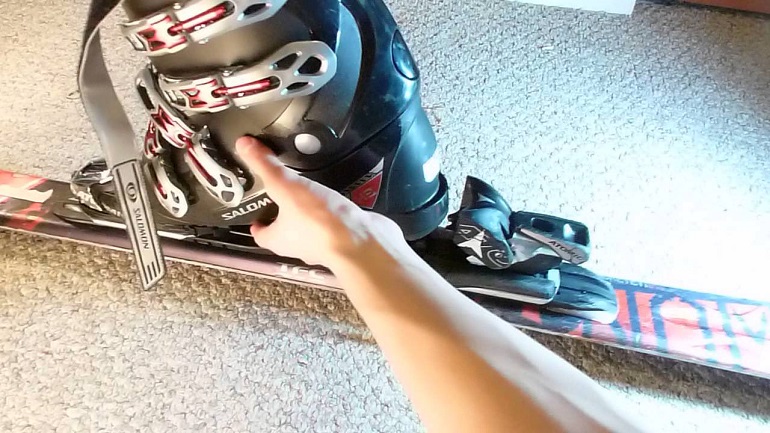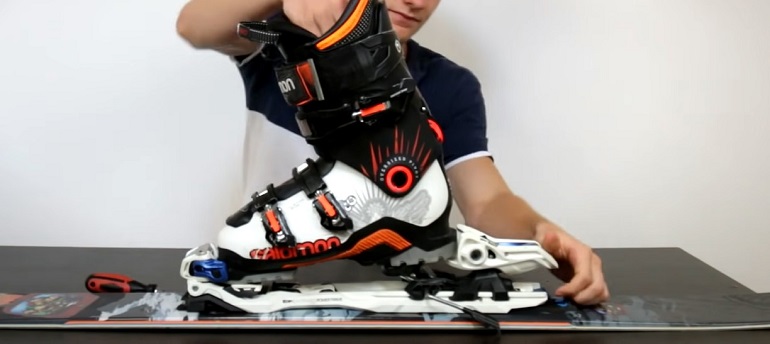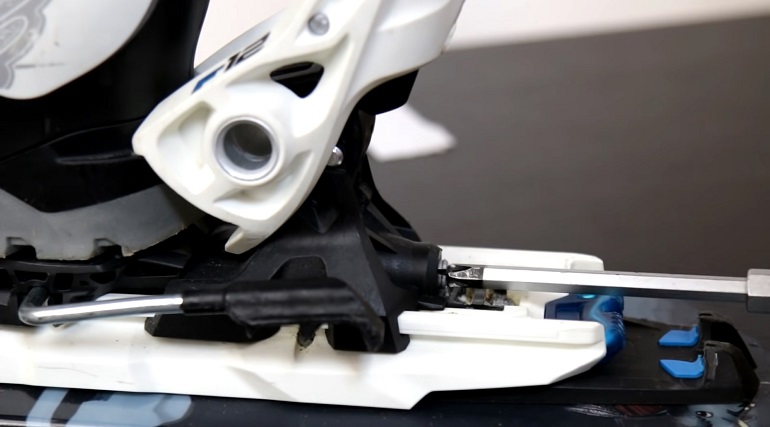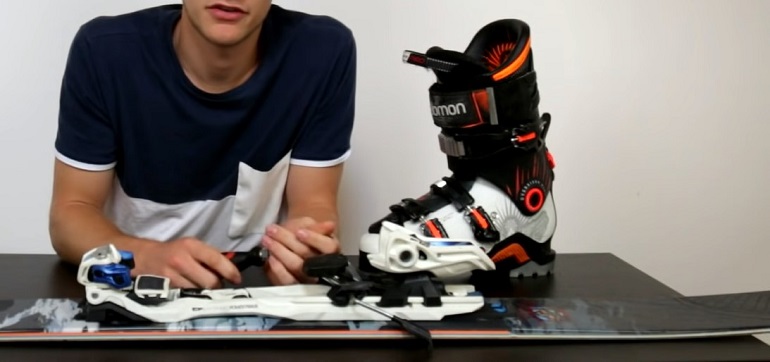Don’t Panic!
You’re at the slopes one day, and everything feels as it should. You know, a freshly paved piste underneath your skis. Top-of-the-line ski bindings that are responsive without needing to place your ski boots in a stranglehold.
It’s such a great experience that you decide to set a date for another ski day. This time, in the backcountry. But something is wrong with your touring ski binding, the feeling is completely different.
Adjust ski bindings? Yeah, now is the time to learn how to do this. Learning how to adjust ski bindings is important not just for your own performance but also as a safety concern. And it’s not a simple task.
When adjusting ski bindings, you will have to take into account your boot length and the terrain you’re riding in. If you want to avoid serious injury, then you are going to have to closely follow the steps outlined below.
Why Would You Want to Adjust your Ski Bindings?

This is a great question to ask. Why even bother going through the process of learning how to adjust ski bindings? You could just stick to the terrain that your ski bindings are optimized for. Avoid all else.
You could just have your local ski shop tech take a look at them. Can’t go wrong with having a professional handle the issue. While these are all great suggestions, you’ve got to see the bigger picture.
How can you hope to improve if you don’t know how your binding works?
Perhaps, skiing to you is for leisure and nothing more. Even if this is the case, you should still want to learn how to properly adjust your ski bindings.
Can’t have much leisure if you have to stop your skiing fun and go to the ski shop, just to have your ski bindings adjusted.
The answer to the why, is that not only will it improve your skiing ability level, but it also allows you to have a better time skiing. And more time skiing in general.
How To Adjust Ski Bindings: Step-By-Step
Before we begin, like most adjustment jobs, you are going to need some tools. The good thing is that only a screwdriver is required to properly adjust your ski binding(s). You could also pick up a multi-tool at most ski shops.
Everything else needed will be what you have on you. Namely, information pertaining to the rider you are making the adjustments for (probably yourself). Keep in mind, that this is a general outline that should work with most best ski bindings.
If you are having trouble following the steps or feel as if your own ski bindings require different adjustments, then don’t hesitate to visit a ski shop near you. They should be able to sort you out.
Step 1 – Adjusting The Toe Piece

Clear whatever flat surface or table is available to you and set your skis on top of it. Release the brakes of your bindings, located on the outer side of your bindings.
Grab a ski boot (the one that you’ll be attaching to your bindings) and check the heel piece. You should find the length of your boot’s sole written in millimeters. With this number, you are now ready to open up your bindings.
Hold down on your binding’s two levers, grab your ski boot and then shove the toe piece into the front of your binding. As far in as possible. Now, lower your boot’s heel piece into place, and it’ll secure itself. You should be able to hear a snap for confirmation.
Upon completing the steps above, if your boot isn’t slotting into place, then you either need to widen or shorten the width of your bindings. This is where that screwdriver from before will come in handy.
Loosen the toe piece to make your bindings wider. Tighten the toe piece to make the width smaller. A newer binding type may not require the use of a screwdriver to adjust its width.
Step 2 – Adjusting Your Heel Length

The heel piece may have clicked into place, but you still haven’t set its length. Direct your attention to the rear of your bindings. There, you’ll find a screw that you will want to loosen.
Once this screw has been loosened, you will be able to lift and move the binding forward or back. Move the binding according to your boot length. Make sure it’s a tight fit. You don’t want to leave any wiggle room for safety reasons.
Wiggle room means that your boot will slip out of your skis during intense riding.
Once you have achieved that tight fit, tighten the screw that you loosened before. Keep in mind, that as you tighten the screw, the fit may get even more airtight. This is fine as long as two things are true:
- First, you have a comfortable placement of your boot and binding.
- Second, the fit is secure, and your boot can’t be moved out of place.
Both steps one and two are vital because this is the fitting process. If you don’t have something that feels secure or comfortable, then you will need to redo both steps. You could be at this for a while, but it’ll be worth it.
For your safety and comfort, don’t take any shortcuts here.

Step 3 – Adjusting The DIN Release Setting
Before we get ahead of ourselves, allow me to explain just what a DIN setting or DIN release setting is. A DIN setting is the release force setting of your ski bindings. Okay, that’s great, but what’s a release force setting?
A release force setting is a number that determines the amount of force required to eject you from your bindings. The reason why upon heavy impact, your bindings release you, is to lessen the probability of you suffering a serious injury.
This is something that I hope you won’t ever activate. Nonetheless, it is still important to set it and not have it too low or too high.
Around the toe and heel pieces of your bindings, you’ll notice a series of numbers. Adjusting this setting is different for both your toe and heel.

DIN setting – Toe
- On the sides of these numbers, you’ll find a screw. It can be hidden, usually on the inside of the binding. With a screwdriver, turn the screw clockwise, and this will raise the strength of the impact needed to eject you from your skis.Turning this screw counterclockwise will lower the release setting. Meaning that the strength of the impact needed to eject you will be smaller.
DIN setting – Heel
- Grab the heel piece of your binding and lift the lever end upward. There should be a screw located within the top of the heel piece. The part that you lifted up. The same rules apply here.Turn the screw (with a screwdriver) clockwise to raise your DIN setting and counterclockwise to lower your DIN setting.

To get the right DIN setting, you’ll have to take into account the rider’s weight and size. Don’t set it too low, or you’ll be ejecting out of them with every bump but setting it too high is dangerous.
Remember, the right DIN setting number differs depending on the rider’s weight.
FAQ
Can I Mount New Bindings on Old Skis?
The straight answer is yes, you can mount your ski bindings on skis that have already had other ski bindings installed on them in the past. However, you will have to drill new holes into your skis to accommodate your new ski binding(s).This sounds well and all, but there is one issue.
Every time you drill holes into your skis, you are further compromising their structure.Each batch of holes further weakens the structural integrity of the skis. This can be potentially dangerous. Any rough riding, hard lands, tight turns, etc could result in your skis snapping into pieces.
This is extremely dangerous, and I would advise you to purchase a new pair of skis if you’ve already drilled 3 different sets of holes into your existing skis.
How Much Does an In-store Installation Cost?
Questions as broad as these are going to have differing answers. Any number of factors come into play here. Including your location, skis, bindings, and the shop itself.
But a common price that you’ll come across is around $50.Although, when you purchase ski bindings through a store. They may come with a free mounting service thrown in. These kinds of deals are great for beginner skiers that obviously don’t have much experience with mounting ski bindings.
Do I Need Ski Boots to Install Bindings?
The answer I’ll give you (which I’ll explain in a moment) is yes. But technically no, you can mount your ski bindings without having any ski boots around but do not do this. The reason why you need a ski boot to mount your ski binding(s) is that you’ll need your boot sole length to have your skis properly adjusted.
Sure, if you have your boot sole length written down, then a shop could mount them for you with just that. However, you are going to need to adjust your own ski bindings to your ski boot anyway. Might as well have them with you, ready to get the job done.

My Final Thoughts
Now that you know how to adjust your ski bindings, you’ll be able to make those sharp turns in complete confidence. Don’t feel like something is right? Then just plop down anywhere (steer clear of the other riders) and adjust what you need to.
Some general information to remember would be:
- When you screw something in, be sure not to over-tighten anything. Otherwise, the screw could break, and you’ll need to purchase a new pair of ski bindings.
- Remember that it is your sole length that will be used to correctly fit your ski binding.
- Ski tech evolves every year. If you want to ski safely, then choose ski bindings that are at your skill level.
Need a second opinion? I don’t blame you, this is something that you’ll want to get right. Head on over to your local ski shop, and I’m sure they’ll tell you whether you are good to go or not.
0 Comments